Blog
Cloud Phone System
What Is Call Monitoring and Why Is It Important?

What Is Call Monitoring and Why Is It Important?
Learn what call monitoring is, how it works, and how call monitoring tools improve service quality and agent performance.
As a call center owner or manager, you know that to successfully run a call or contact center, you must not only manage inbound and outbound calls but also continuously train agents and monitor calls to ensure they meet quality standards and hit your KPIs.
One of the best ways to ensure your contact center operates to standard is to continuously monitor both inbound and outbound calls. That might sound like an overwhelming process, but luckily, modern call monitoring software can streamline and organize the work.
In this article, we’ll explain what call monitoring is, the most common methods to implement it, and how call monitoring tools help businesses improve service quality and agent performance.
What is Call Monitoring?
Call monitoring, sometimes called call center call monitoring or simply call center monitoring, is the practice of reviewing live or recorded phone conversations to assess quality, performance, and compliance. In a call center, this means evaluating interactions between customers and agents (support, sales, billing, etc.) to confirm that service standards are met.
The goals are to gauge call quality, measure agent effectiveness, and uncover opportunities to improve the customer experience. By monitoring calls consistently, businesses can spot conversational pain points, understand customer needs, coach agents with real examples, and maintain a reliable, consistent level of service.
In short, call monitoring gives organizations, from small teams to large enterprises, actionable insight into how calls are handled, helping increase customer satisfaction and operational efficiency.
How to Monitor Call Center Performance?
Monitoring performance works best when you combine real-time oversight with post-call review. Here are the core methods, when to use them, and what they’re best for.
Live Call Monitoring
Live call monitoring lets supervisors or managers join an active call between an agent and a customer without disrupting the conversation. They can hear both sides in real time. Most modern systems support three modes:
- Call listening (silent monitoring): The supervisor listens to an active call in real time without either party knowing and without transmitting any audio back. It’s useful for unbiased QA scoring, checking script adherence, reviewing tone and process, and sampling many calls quickly. The advantage is zero disruption to the customer experience and easy calibration across reviewers, though it doesn’t provide real-time help to the agent.
- Call whisper: The supervisor speaks only to the agent while the customer cannot hear, providing in-the-moment guidance during the conversation. It’s effective for objection handling, compliant phrasing, and prompting the right upsell or next step. The benefit is immediate support without affecting the customer experience, but too much whispering can distract the agent.
- Call takeover (barge/barge-in): The supervisor joins the call and, when necessary, assumes control of the conversation. This is best for escalations, VIP or regulated scenarios, high-risk complaints, or complex negotiations that require authority. The strength is immediate control to protect customer experience and compliance, though it can feel abrupt if not introduced well.
On-Demand Call Monitoring
On-demand call monitoring pairs monitoring with call recording so you can evaluate interactions after the call. Calls are captured as audio files (and, optionally, agent screen recordings) and stored in your call center monitoring platform. Supervisors and managers can replay any moment, review the context, and assess what was said and how it was handled.
To safeguard customer data, establish clear policies for consent and disclosure, retention periods, and access controls. Use role-based permissions, encryption (in transit and at rest), and redaction of sensitive information (e.g., payment details, personal identifiers).
AI-Powered Automation & Analytics for Call Monitoring
Modern call monitoring goes far beyond supervisors manually listening to calls. With AI-driven automation, every conversation can be transcribed, analyzed, and categorized without human effort. Whether a manager is monitoring in real time or not, AI can capture the call, generate a transcript and summary, detect customer sentiment (happy, frustrated, neutral), and apply predefined tags for easier organization and reporting.
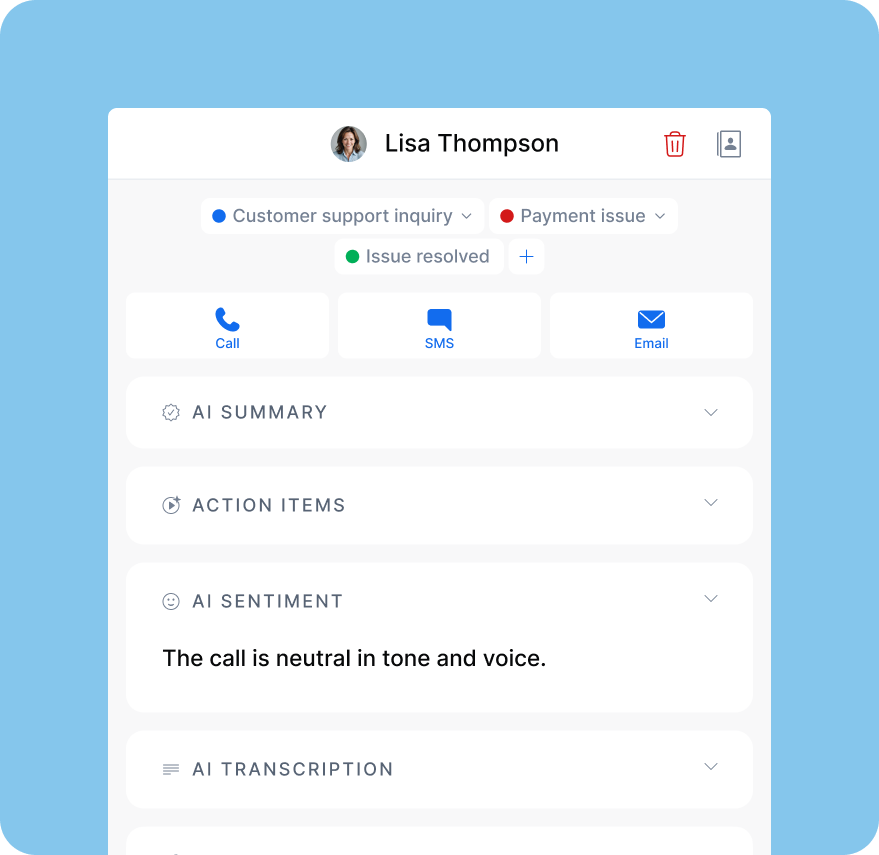
Some platforms take this further by automatically reviewing all calls. Instead of a supervisor listening to 5 out of 100 conversations, AI can analyze every single one and flag the interactions that need attention. This approach helps small teams without dedicated QA staff by handling much of the heavy lifting, such as spotting compliance issues, identifying recurring pain points, or highlighting coaching opportunities.
The most effective use comes from combining automation with human review. AI flags trends and outliers, while managers and QA leaders validate the findings and provide final evaluations. This balance gives teams complete coverage, consistency, and actionable insights without overloading supervisors with endless hours of call listening.
Benefits of Call Monitoring: Why It’s Important to Your Small Business
Call monitoring and recording aren’t just about oversight; they’re powerful tools that help businesses strengthen performance, improve customer experience, and run operations more efficiently. They offer multiple benefits; here are some of the key benefits:
Identify Opportunities for Coaching and Training
By reviewing calls, managers can pinpoint areas where agents may fall short of meeting standards or KPIs, such as handling objections, following scripts, or maintaining the right tone. These insights turn into valuable coaching opportunities. Real calls provide practical examples that make training more relevant and help employees apply feedback effectively.
Improve Agent Performance
Call monitoring isn’t only about scoring performance; it’s also about understanding where agents need more support. When employees feel heard, supported, and empowered, they’re more engaged and confident in their roles. Consistent feedback, encouragement, and recognition based on real call data not only strengthen their skills but also boost motivation, enabling them to deliver better results for your business.
Enhance Customer Satisfaction and Sales
Better-trained and better-prepared agents deliver smoother customer interactions, which directly impacts satisfaction scores, loyalty, and even sales conversions. Monitoring ensures that service quality is consistent, messages are clear, and upsell opportunities aren’t missed.
Streamline Remote Team Management
For small businesses and startups with hybrid or fully remote teams, monitoring makes it easier to manage performance without being in the same office. Supervisors can review calls asynchronously, track compliance, and support agents wherever they work, ensuring consistent service delivery across locations.
Who Can Benefit from Call Monitoring?
No matter the size of your business, if you handle inbound or outbound calls for customer service or sales, call monitoring is a crucial practice. Here’s who can benefit the most:
Call Centers
For call centers, call monitoring software is one of the most important tools for monitoring call center quality. With high call volumes, relying on manual spot checks alone isn’t enough. Call monitoring software helps scale quality assurance by automatically capturing interactions, tagging calls for review, and even using AI analytics to detect patterns in sentiment, tone, or compliance. This ensures that performance issues don’t slip through the cracks and that coaching opportunities are identified early.
By embedding call monitoring into daily operations, call centers can deliver more consistent service, reduce errors, and provide agents with targeted feedback that improves both customer satisfaction and business outcomes.
Technical and Customer Service Teams
Customer support teams rely on monitoring to make sure customer issues are resolved clearly, accurately, and empathetically. It helps managers track adherence to troubleshooting processes, improve resolution times, and ensure customers leave with a positive impression of the brand.
Sales Teams
Sales teams benefit from call monitoring in two key ways. First, it provides managers with insights into how well reps handle objections, follow scripts, and guide conversations toward conversions. By reviewing live or recorded calls, managers can refine pitches, identify missed upsell or cross-sell opportunities, and improve the overall sales process.
Second, call monitoring is a powerful training tool for onboarding new reps. Listening to real conversations, both successful and challenging, gives them practical examples of how to navigate customer interactions. Whether it’s shadowing live calls or studying recordings, new hires gain valuable context that accelerates their learning curve and prepares them to sell more effectively.
Marketing Teams
Although marketing teams rarely interact with customers directly over the phone, call monitoring can be an invaluable source of insight. It allows marketers to hear how sales teams present products or services and check whether pitches align with the intended messaging. Just as importantly, it gives them direct access to the customer’s voice to understand how customers perceive the product, the questions they ask, and the objections they raise.
These insights can influence more than just messaging. They can inform product development, highlight gaps in positioning, and inspire more effective campaigns. By listening to real conversations, marketers can ensure their messaging resonates with actual customer needs and expectations, creating tighter alignment between marketing, sales, and product strategy.
Best Practices for Implementing Call Monitoring in Small Businesses
Below are some of the best practices to ensure a successful call monitoring program:
Define What “Quality” Means for Your Business
Before you begin monitoring, decide what a “quality” call looks like in your context. Build clear evaluation criteria that reflect your business goals and customer expectations. For example, you might assess whether:
- The agent greeted the customer politely.
- The issue was verified correctly.
- The agent followed the compliance script.
- Accurate and helpful information was provided.
- The issue was resolved or properly escalated.
These standards form the foundation for your monitoring and feedback process.
Set Clear Objectives and Metrics
Once quality is defined, connect it to measurable outcomes. Identify the KPIs you want to improve through monitoring, such as First Call Resolution (FCR), Average Handle Time (AHT), Customer Satisfaction (CSAT), or QA score averages.
Communicate these objectives to your team so they understand why calls are being monitored. For example: “Our monitoring focus is on resolving issues in a single call and delivering excellent customer experiences.”
Periodically review your chosen metrics to ensure they still align with business goals and make adjustments as needed.
Develop a Standard Evaluation Form or Scorecard
Use a structured scorecard to evaluate every call consistently against your defined criteria and metrics. This ensures fairness, removes guesswork, and makes it easier to track trends across agents and calls.
Provide Timely and Constructive Feedback
Feedback should follow closely after call reviews. Highlight strengths first, then offer specific, actionable improvement tips. Keep it a coaching conversation, not a lecture, so agents feel supported and motivated to improve.
Foster a Positive Culture Around Monitoring
Normalize monitoring as a routine practice that benefits everyone. Encourage self-monitoring and peer learning. Celebrate improvements and recognize great calls so the program feels encouraging rather than punitive.
Ensure Compliance and Data Security
Always comply with consent laws and protect customer data. Use disclosures where required, limit access to recordings, and secure files with encryption and retention policies.
Create a Call Monitoring Strategy Document
Document your approach: how often calls are monitored, which tools you use, who’s responsible, and how feedback is shared. Even a simple one-page strategy helps ensure consistency and makes onboarding new hires easier.
Legal and Ethical Considerations in Call Monitoring
Call monitoring involves recording or listening to conversations, which makes legal compliance and ethical practice essential. While monitoring is permitted in most jurisdictions, businesses must understand the rules that apply in their region to avoid liability and maintain trust.
Consent Laws (One-Party vs. Two-Party)
Consent is the cornerstone of call monitoring. In the United States, federal law allows one-party consent, meaning if one participant (e.g., your employee) knows and agrees to the recording, it is legal. However, several states require two-party or all-party consent, which means both the agent and the customer must be informed and agree. That’s why you often hear messages like “This call may be monitored or recorded for quality assurance” at the start of calls. If your business operates in multiple states or countries, follow the strictest applicable consent standard to stay safe.
Proper Disclosure
Transparency protects both your business and your employees. Customers should always be notified through a pre-call announcement or verbal confirmation when calls are being monitored. Secret monitoring risks not only breaching the law but also breaking trust with your team.
Data Protection and Privacy
Call recordings contain sensitive personal data such as names, phone numbers, and possibly payment details. Regulations like GDPR in Europe or CCPA in California impose strict requirements on how this information is stored, accessed, and used. Best practices include encrypting recordings, restricting access to authorized personnel only, and defining retention periods to avoid keeping data longer than necessary.
Regional and Industry-Specific Regulations
Different regions and industries often impose unique, and sometimes stricter, requirements on call monitoring. For example, financial services firms may be legally obligated to record all client communications to ensure compliance and prevent misuse of information. In contrast, healthcare organizations must follow strict medical privacy regulations, such as HIPAA in the United States, when handling patient-related calls.
In these situations, businesses must comply not only with general laws on call monitoring and consent but also with industry-specific mandates. This means implementing stricter controls, securing data appropriately, and ensuring monitoring practices align with both regional legislation and sector regulations.
In short, always secure proper consent, provide clear disclosure, and safeguard recorded data with strong security measures. Doing so not only minimizes legal risks and avoids costly penalties but also demonstrates transparency and ethical responsibility to your customers.
What is Call Monitoring Software?
Call monitoring software is a standalone software or add-on that help with monitoring tasks. More often, call monitoring is included in more advanced call center solutions or phone systems.
Key Features of Call Monitoring Software
Modern call monitoring software offers much more than just listening in on calls. The best solutions combine oversight, automation, and analytics to help businesses improve service quality, compliance, and agent performance. Here are the core features to look for:
Live Call Monitoring
Supervisors can join active calls in real time to evaluate performance and intervene when needed. Most platforms include options for:
- Silent Listening: Monitor without interrupting the call.
- Call Whisper: Coach agents live without the customer hearing.
- Call Takeover (Barge-In): Join and take over calls when escalation is necessary.
Managers can also use features like group calling to join live conversations and listen in real time.
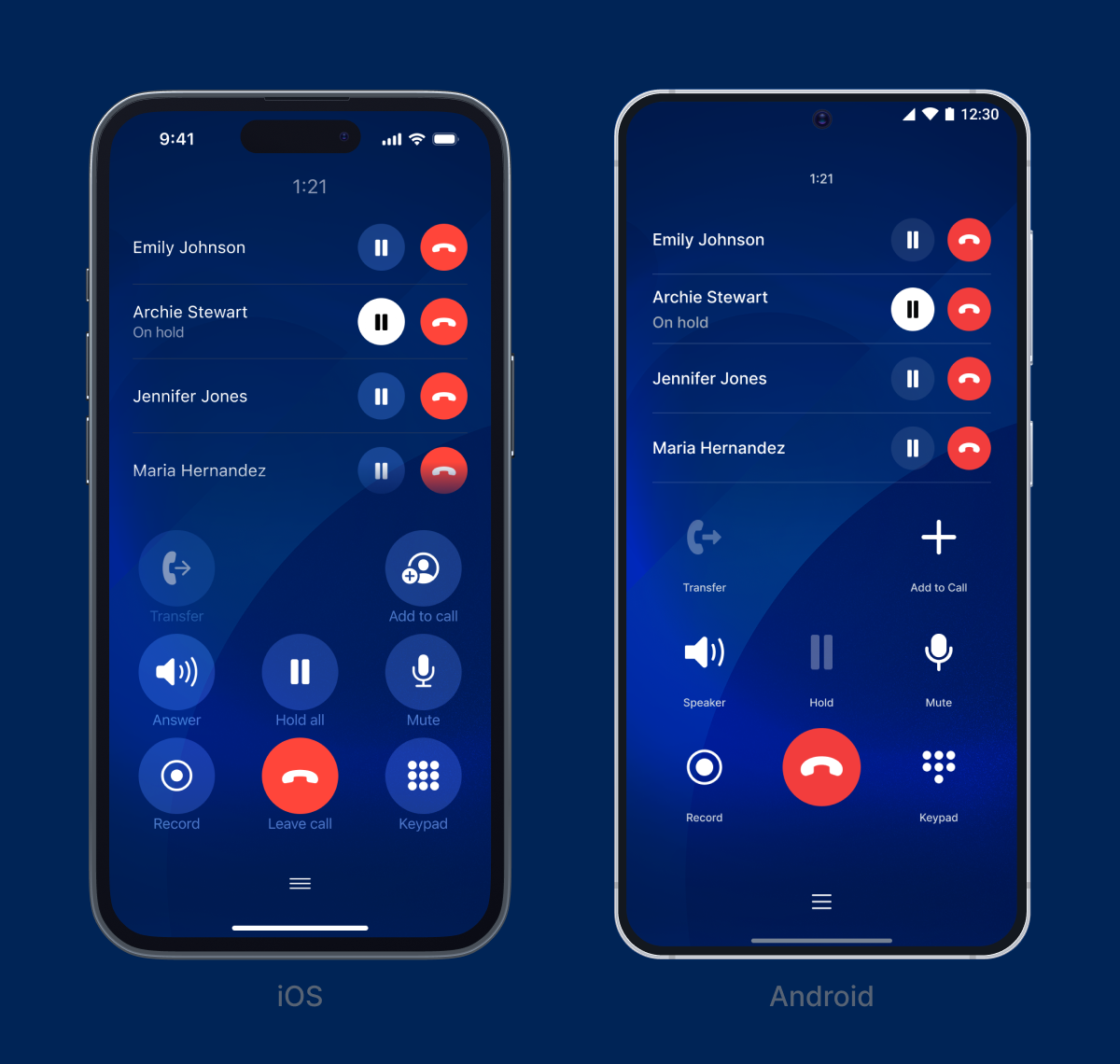
Call Recording
Conversations are automatically recorded and stored for later review. Managers can replay specific moments, assess call quality, and use call recordings for training or dispute resolution. Many platforms also include screen recording to capture what agents do during the call.
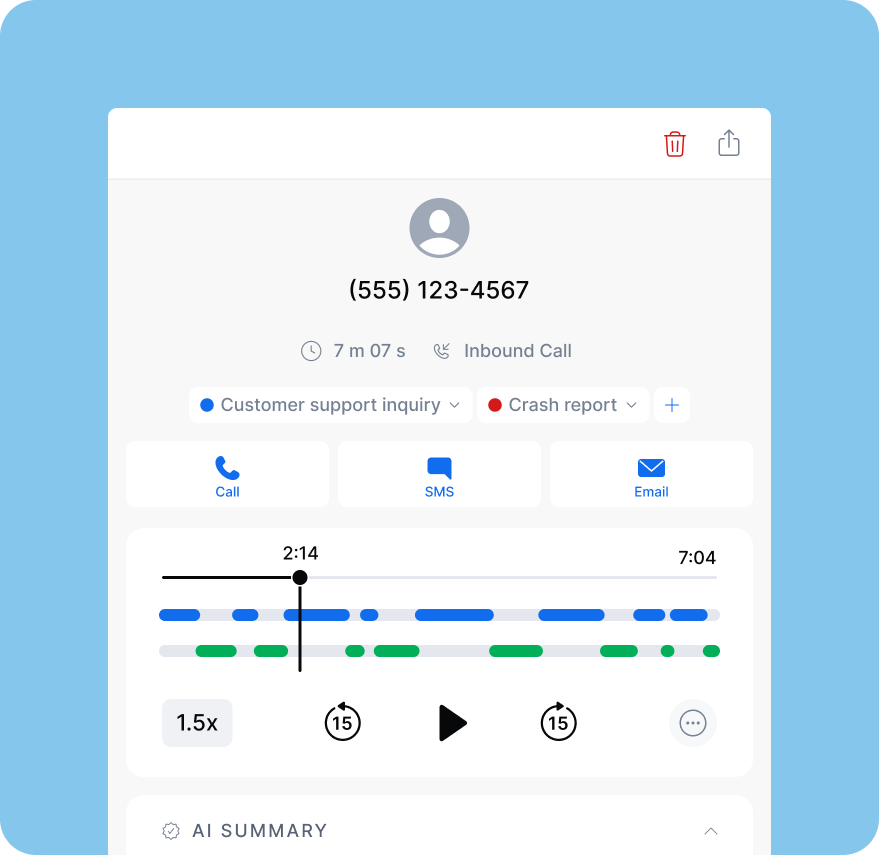
Transcription and Call Summaries
AI-powered transcription automatically converts spoken conversations into text, making calls easy to search, review, and analyze. Paired with automated summaries, it highlights key points, saving managers time while ensuring nothing important is missed.
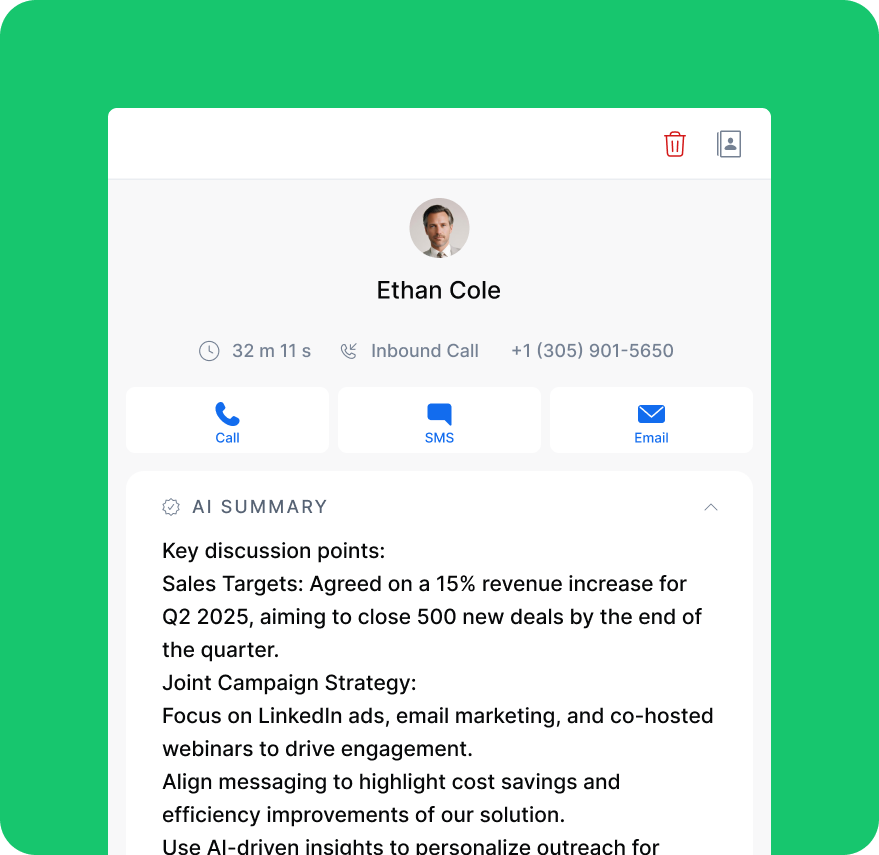
Sentiment and Emotion Analysis
AI sentiment analysis detects and records customer emotions, such as frustration, satisfaction, or neutrality, helping supervisors understand the customer’s experience beyond words alone.
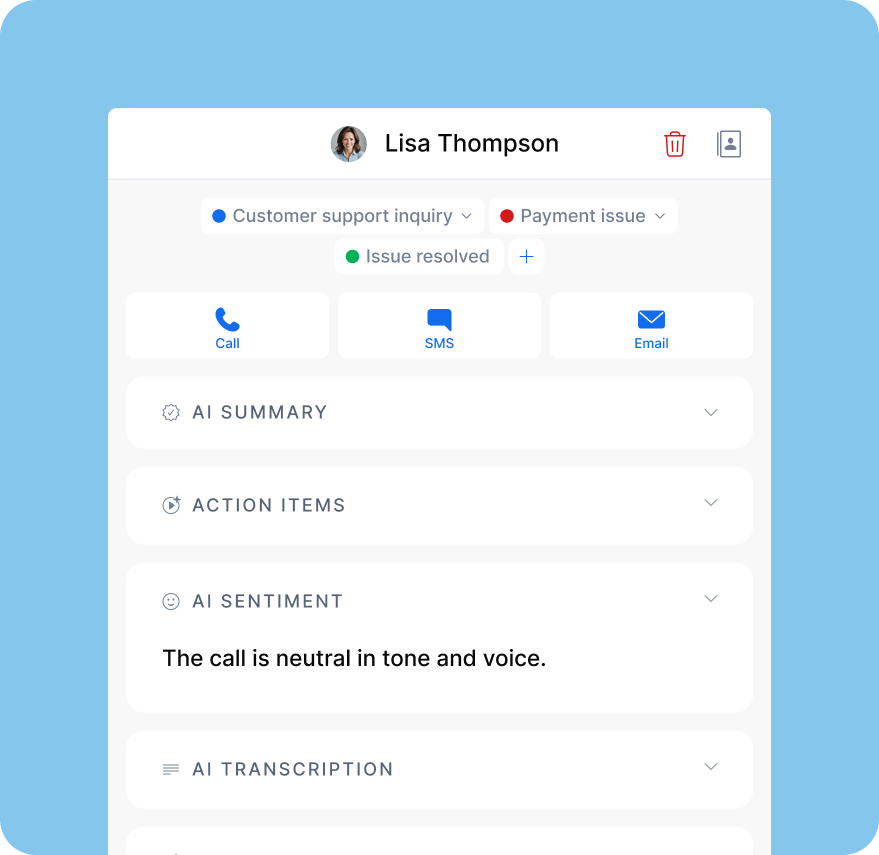
Compliance and Security Features
To protect sensitive data, platforms often include role-based permissions, encrypted storage for call recordings and customer data, and customizable retention policies. These features help businesses stay compliant with regulations like GDPR, CCPA, HIPAA, or PCI-DSS.
Analytics and Reporting
Dashboards and reports provide insights into KPIs such as average handle time, first-call resolution, QA scores, and customer sentiment. These analytics help track trends, compare agent performance, and identify areas for process improvement.
Integration with Business Tools
Many call monitoring platforms integrate with CRMs, helpdesk systems, and workforce management software. This allows call data to sync with customer records and ensures monitoring directly supports broader business processes.
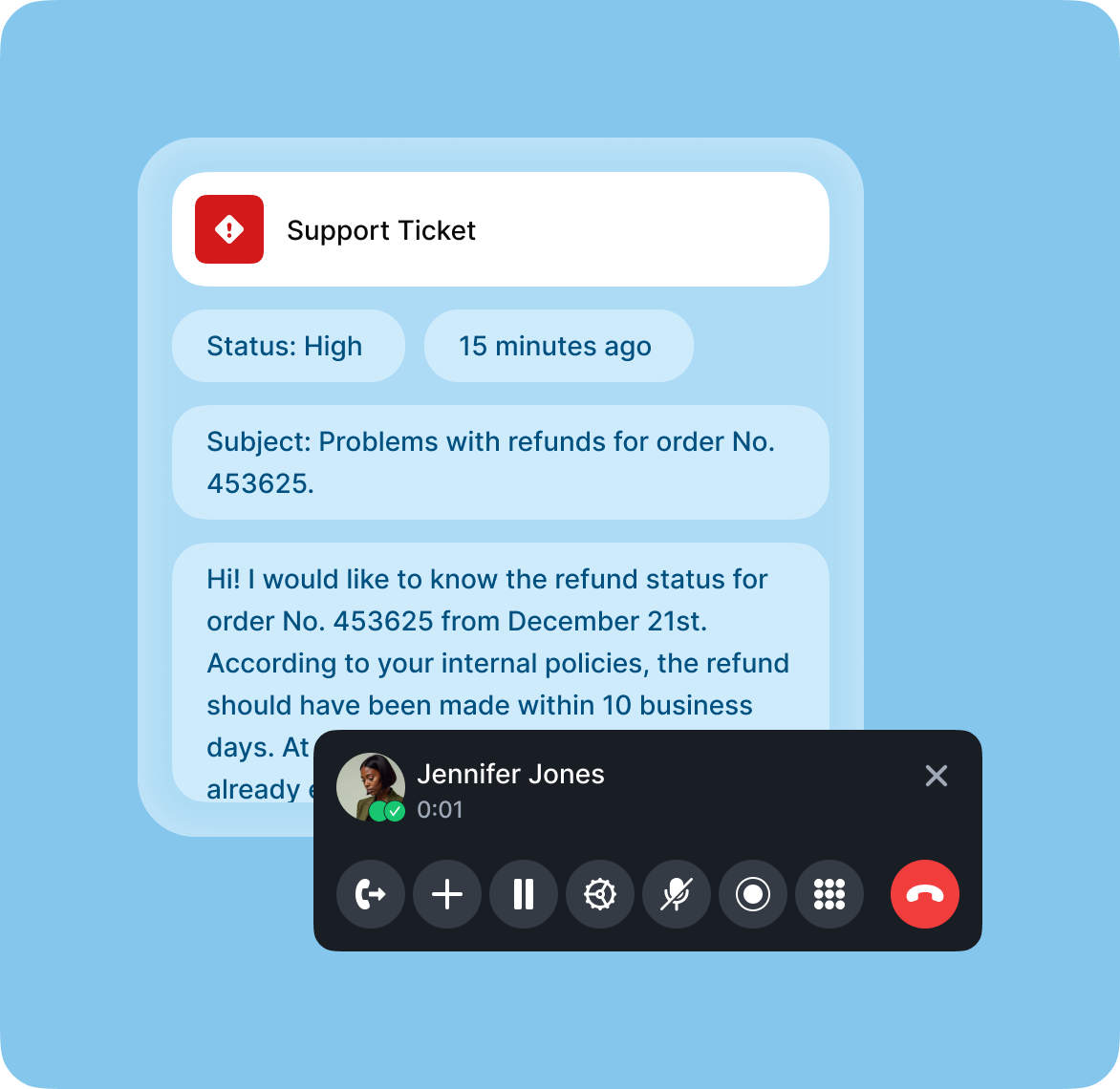
Mobile App Support
Modern call monitoring software isn’t limited to the desktop; it often comes with mobile app support so supervisors and managers can stay connected on the go. With mobile access, managers can listen to live calls and review recordings directly from their smartphones or tablets.
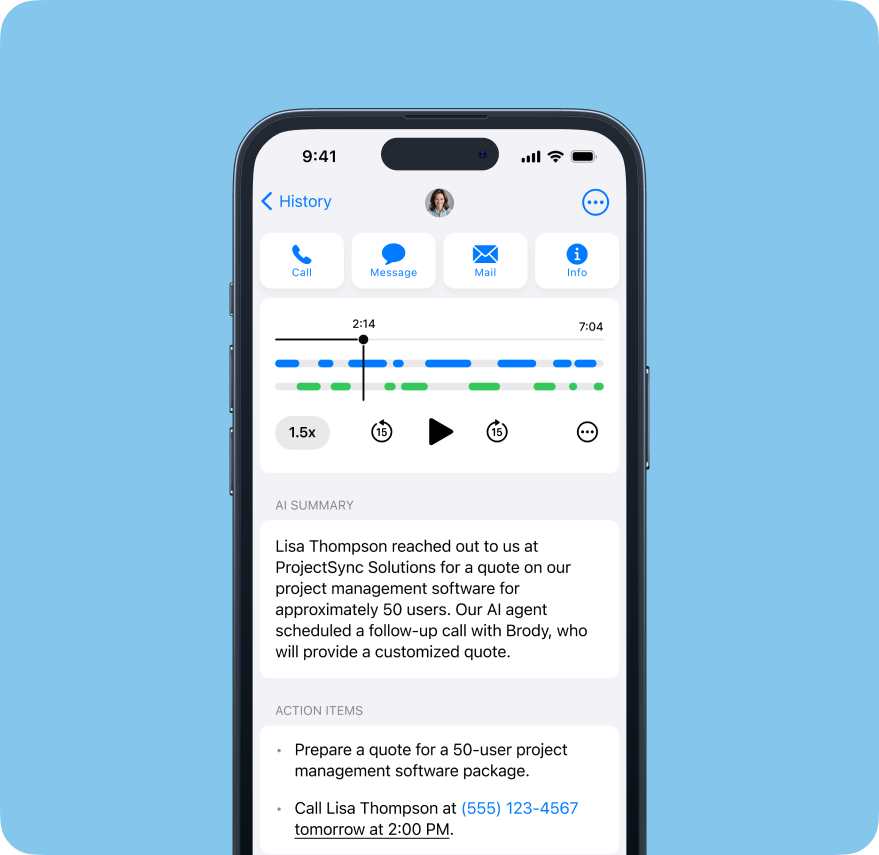
Conclusion: The Role of Call Monitoring in Small Business Success
Call monitoring is far more than just listening to phone calls; it’s a strategic tool for improving communication, elevating customer service, and building stronger teams.
Think of call monitoring as an ongoing learning process. Every monitored call offers insights into how well your team engages with customers, how effectively issues are resolved, and where training or process improvements are needed. In a marketplace where customer expectations continue to rise, businesses that listen, adapt, and refine are the ones that stand out.
Looking for more than a call monitoring software?
DialLink’s AI phone system offers a wide range of features to help you monitor calls, but it doesn’t stop there. It also provides advanced call management tools, integrated business messaging, and AI-powered automation. Designed specifically for small businesses and startups, it’s simple to implement and built to scale with your needs.
Call monitoring is the process of listening to or recording phone conversations between customers and employees to evaluate service quality, train staff, and ensure compliance. It helps businesses improve customer experience and agent performance.
Yes, but it depends on the laws in your region. In some places, only one party needs to consent to a monitored call, while others require both the customer and the employee to be informed. To stay safe, always notify callers with a message like: “This call may be monitored or recorded for quality assurance.”
Call monitoring refers to listening in on live calls as they happen. A manager or supervisor can silently monitor a call to assess performance, provide real-time coaching through whisper mode, or even join the call directly through a feature called barging. The purpose of monitoring is to support agents during challenging calls, ensure quality in real time, or step in if a situation escalates.
Call recording means capturing conversations as audio files that can be reviewed later. Recordings are typically stored securely in the business phone system or cloud and can be replayed to evaluate agent performance, resolve customer disputes, and train staff. Recording enables managers to review a higher volume of calls at their own pace and maintain a record for compliance or legal requirements.
Yes, in two-party consent regions, if a customer doesn’t agree to monitoring, the business must either not record the call or end it. Clear disclosure and obtaining consent up front avoid issues.
Share this post

Arina Khoziainova
Content Writer at DialLink
Arina is a content writer with over 7 years of experience in the IT industry. At DialLink, she creates clear, insightful content that helps small business and startup owners simplify communication and drive growth using modern tools. With a strong focus on practical value, Arina transforms complex topics into accessible, actionable stories.
Keep Reading

What Is a Call Log and Why Is It Essential for Small Businesses and Startups?
Learn what a call log is, the insights it provides to businesses, and how call log apps and software help you review call log history.
August 14, 2025
11 minutes

What is an Outbound Call Center? Everything SMBs and Startups Need to Know
Learn what an outbound call center is, why it’s important for businesses, and how outbound call center services and software help them operate efficiently.
August 29, 2025
20 minutes

What Is PBX? A Complete Guide to PBX Phone Systems
Discover what PBX is, how it has evolved from traditional systems to cloud solutions, and how it is now part of broader cloud-based business tools.
August 29, 2025
9 minutes

What Is a Virtual Phone Number and How to Get One for Your Business?
Learn what virtual phone numbers are, how they work, the types available, and how to get one for your business with DialLink.
August 27, 2025
17 minutes